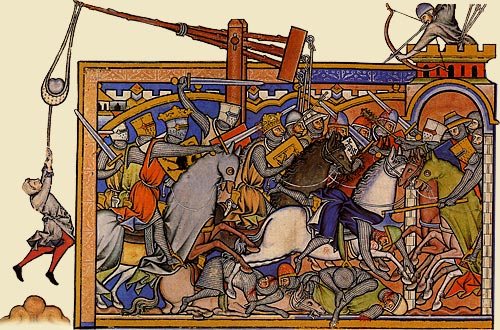 The Tournaments of
The Tournaments of
the 12th Century
By Conde Fernando Rodriguez
de Falcon (Fernando Vigil)
Part I
What is a tournament?
For most of us in the SCA, the word “tournament”conjures several images. Perhaps you envision two combatants
striding into an enclosed list field, to prove their skill before the assembled gallery. Or perhaps you think of the joust, where a pair of knights would race along the
barrier with lances leveled, to test their
mettle man to man.
But the tournaments of the late twelfth century were a very different story.
First, we must put aside the idea of a simple combat between two men. The tournaments William Marshal competed in were melees between a great many competitors, the majority of whom would come in the company, or mesnie, of a powerful Lord. While a man's individual prowess was certainly important, these mesnies would often fight as a unit. And if a comrade was in trouble such companions would certainly come to the aid of their compatriots if they could.
Next we must discard the ideas of a small, enclosed field of honor. The tournaments of this era were more wide ranging, and the areas they encompassed were much more loosely defined. A tournament might run from one village to another miles away, or from one river to another. Within those areas, almost everything was fair territory, and the knights would range freely. Certainly the knights would often ride through woods and over meadows, but the chronicles also tell of men fighting in and through villages and into the buildings; trampling crops in farm fields and vineyards; and even taking refuge in small fortifications.
In many ways the tournaments from the age of William the Marshal were much more like war than the later period tournaments we so often envision.
In large part, the business of the twelfth century knight was war. And the tournament was the best forum the knights of this age had to ready themselves for it. Aside from the most obvious chance to practice with their horse, spear, and sword, the tournament was also a place to learn the rules and customs that governed the culture of the fighting aristocracy.
The tournament also held two other major attractions for the knight of this era – glory and wealth.
A man who proved successful in the tournament could earn great fame and renown. In a way the heroes of the tournament were the sports stars of their day. Just as modern sport starts might turn this fame into endorsement deals, the champions of the tournament field could often parley their success into a place in the household of a powerful Lord and possibly even beyond. This was a position that could ensure a young man with few prospects security for many years to come.
William Marshal is of course the classic example of this. Thanks to his skill he advanced from a fourth son with little to call his own to become one of the most powerful men in all of England.
By the twelfth century, the earlier practice of dividing a Lord's lands between his sons was almost gone. The eldest would inherit the bulk of a family's land and wealth, often leaving little but a token for a second or younger son. For these men, the possibility of ransoms earned for men captured in war or on the tournament field was one of the few ways to achieve wealth.
Though some tournaments were fought a plaisance, or “for pleasure” with blunted or rebated weapons, others were fought a l´outrance, or “to the utmost” with actual weapons of war. In these a l´outrance tournaments the major goal was the capture of one's opponents.
An opponent who could be made to submit could be taken prisoner, and a ransom would be negotiated for their release. The victor could typically claim the captured man´s horse and/or armor, but a cash payment or ransom was often agreed to in its place. If a man could not raise the required payment, they could be released on their own parole to raise the necessary funds.
The gain or loss of a horse or armor was no small matter, for they were extremely expensive. A few ransoms earned could provide a knight with a very nice living, but if a knight lacked the funding to replace them he could find himself unable to return to the tournament field. Many a landless knight found himself desperately seeking the patronage of a wealthy noble who could supply them with a horse or armor to allow them to continue their career.
By the late twelfth century, tournaments would be announced weeks or even months ahead of time to allow knights time to gather their mesnies, make preparations, and travel to the tournament´s location. Some Lords had regular mesnies that traveled from tournament to tournament, but just as often the band would be gathered for a specific tournament.
Continued, Part II
![]() Marshal – Flower of Chivalry • Coming to Three Rivers Memorial Day Weekend 2009
Marshal – Flower of Chivalry • Coming to Three Rivers Memorial Day Weekend 2009

